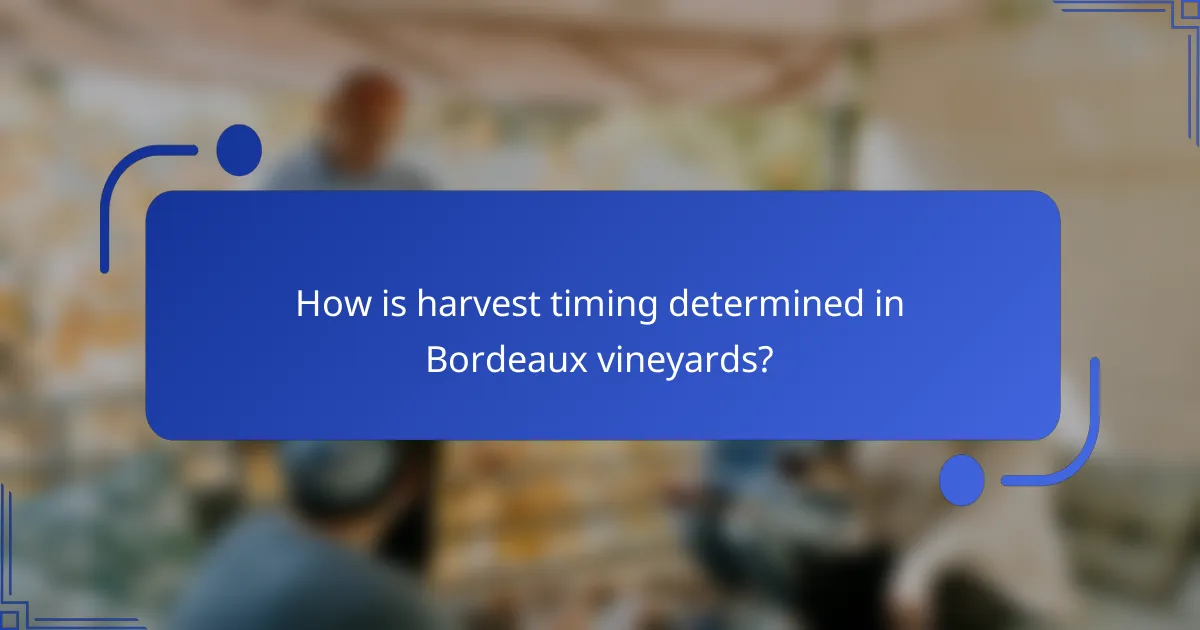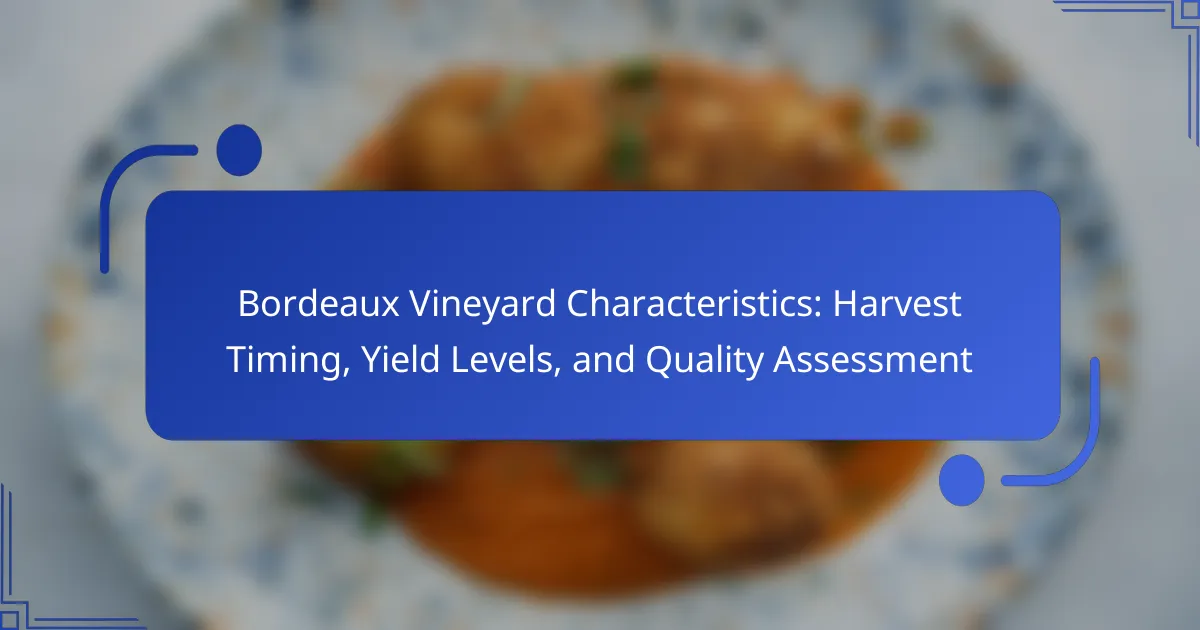
What are the key characteristics of Bordeaux vineyards?
Bordeaux vineyards are characterized by their diverse grape varieties, terroir, and meticulous cultivation practices. The region primarily grows Merlot, Cabernet Sauvignon, and Cabernet Franc. Bordeaux’s terroir includes a mix of gravel, clay, and limestone soils, which influence the flavor profiles of the wines. The climate is maritime, benefiting from mild winters and warm summers. Harvest timing is critical in Bordeaux, typically occurring from late September to mid-October. Yield levels vary, with regulations often capping production to enhance quality. Bordeaux vineyards also emphasize sustainable viticulture practices, ensuring environmental responsibility. These characteristics collectively contribute to the unique quality and reputation of Bordeaux wines.
How does the terroir influence Bordeaux vineyard characteristics?
Terroir significantly influences Bordeaux vineyard characteristics through its unique combination of soil, climate, and topography. The soil types, such as gravel, clay, and limestone, affect drainage and nutrient availability. Climate conditions, including temperature and rainfall, impact grape ripening and flavor development. The topography, including slope and elevation, influences sunlight exposure and air circulation. These factors determine the quality and style of the wine produced. For instance, vineyards in the Médoc region benefit from gravelly soils that retain heat, leading to ripe, full-bodied wines. Studies show that terroir contributes to the distinctiveness of Bordeaux wines, making them highly sought after globally.
What specific soil types are found in Bordeaux vineyards?
Bordeaux vineyards are characterized by several specific soil types. The primary soil types include gravel, clay, limestone, and sand. Gravel soils are prevalent in regions like Médoc and Graves. They provide excellent drainage and heat retention, which benefits grape ripening. Clay soils are common in areas such as Pomerol and Saint-Émilion. These soils retain moisture well, supporting the growth of Merlot grapes. Limestone soils are found in the right bank, particularly in the Côte de Bordeaux. They contribute to the minerality of the wines. Sand soils, although less common, can be found in certain areas and are beneficial for early ripening varietals. These diverse soil types contribute to the unique terroir of Bordeaux, influencing the flavor profiles of the wines produced.
How does climate affect grape growing in Bordeaux?
Climate significantly influences grape growing in Bordeaux. The region experiences a temperate maritime climate, characterized by mild winters and warm summers. This climate provides optimal conditions for grape ripening. Average temperatures during the growing season range from 20°C to 30°C. Rainfall is distributed throughout the year, aiding in vine health.
The climate also impacts the timing of harvest. Warmer years can lead to earlier harvests, while cooler years may delay them. Additionally, climate variability affects grape quality. Higher temperatures can enhance sugar levels, leading to fuller-bodied wines. However, excessive heat may result in overripe grapes, impacting acidity and balance.
These climatic factors are critical for Bordeaux’s renowned wine quality. Historical data shows that climate patterns have shifted over the decades, influencing vineyard management practices. Understanding these climate effects is essential for winemakers in Bordeaux.
What role does grape variety play in Bordeaux vineyard characteristics?
Grape variety significantly influences Bordeaux vineyard characteristics. Different grape varieties possess unique attributes that affect flavor profiles, aging potential, and overall wine quality. For instance, Cabernet Sauvignon is known for its tannic structure and aging ability, while Merlot is recognized for its softer, fruitier characteristics. The climate and soil types in Bordeaux further interact with grape varieties, impacting their growth and ripening. Historical data shows that Bordeaux’s classification system emphasizes specific grape varieties, underscoring their importance in regional identity. Additionally, studies indicate that the blend of grape varieties used in Bordeaux wines contributes to complexity and balance. Thus, grape variety plays a crucial role in defining the distinct characteristics of Bordeaux vineyards.
Which grape varieties are most commonly grown in Bordeaux?
The most commonly grown grape varieties in Bordeaux are Merlot, Cabernet Sauvignon, and Cabernet Franc. Merlot accounts for approximately 60% of the vineyard area in Bordeaux. Cabernet Sauvignon is the second most prevalent variety, making up about 25% of the region’s vineyards. Cabernet Franc is also significant, representing around 10% of the total grape plantings. These three varieties are essential for the production of Bordeaux wines, particularly in the Right Bank and Left Bank regions. The climate and soil conditions in Bordeaux favor these varieties, leading to their dominance.
How do different grape varieties impact wine quality?
Different grape varieties significantly impact wine quality. Each variety possesses unique attributes that influence flavor, aroma, and texture. For instance, Cabernet Sauvignon is known for its bold tannins and dark fruit flavors. Merlot, on the other hand, offers softer tannins and a fruit-forward profile. Chardonnay can produce a range of styles, from crisp and mineral to rich and buttery, depending on growing conditions and vinification methods.
The terroir also interacts with grape varieties, affecting the overall quality. Research indicates that specific grape varieties thrive in particular climates and soils, which can enhance their characteristics. For example, Pinot Noir is sensitive to climate, and its quality can diminish in extreme conditions. Historical data shows that regions like Bordeaux produce distinct wines based on the predominant grape varieties used, such as Cabernet Sauvignon and Merlot, contributing to the region’s reputation for high-quality wines.

How is harvest timing determined in Bordeaux vineyards?
Harvest timing in Bordeaux vineyards is determined by several key factors. The primary factor is grape ripeness, which is assessed through sugar levels, acidity, and phenolic maturity. Winemakers regularly taste grapes and measure their sugar content using a refractometer. Generally, harvest occurs when the sugar level reaches around 12-14% for red wines and slightly lower for whites. Weather conditions also play a crucial role, as optimal harvesting typically happens in dry, sunny periods to prevent rot. The specific varietal characteristics of grapes influence the timing as well. For instance, Merlot is often harvested earlier than Cabernet Sauvignon due to its quicker ripening. Historical data and regional practices also guide decisions, as Bordeaux has a long tradition of timing harvests based on climatic patterns.
What factors influence the timing of the grape harvest?
The timing of the grape harvest is influenced by several key factors. These include climate conditions, grape variety, and vineyard management practices. Climate conditions, such as temperature and rainfall, affect grape ripening. For example, warm temperatures accelerate sugar accumulation in grapes. Grape variety also plays a significant role. Different varieties have distinct maturation timelines. Vineyard management practices, like irrigation and canopy management, can impact harvest timing. Additionally, the desired wine style influences when grapes are picked. For instance, grapes for sweet wines are harvested later. Historical data shows that harvest dates in Bordeaux can vary by weeks depending on these factors.
How does ripeness affect harvest decisions in Bordeaux?
Ripeness significantly influences harvest decisions in Bordeaux. Winemakers assess grape ripeness through sugar levels, acidity, and phenolic maturity. Optimal ripeness ensures balanced flavors and desired alcohol content in the wine. In Bordeaux, harvest timing can vary annually based on weather conditions. For instance, a warm growing season may lead to earlier harvests. Conversely, cooler seasons may prolong the ripening process. Historical data shows that harvest dates in Bordeaux have shifted due to climate change, impacting grape quality. The decision to harvest at the right ripeness level directly affects the wine’s quality and market value.
What are the typical harvest dates for Bordeaux grapes?
Typical harvest dates for Bordeaux grapes are from late September to mid-October. This timeframe allows grapes to reach optimal ripeness. Weather conditions significantly influence the exact dates. For instance, a warm growing season may lead to earlier harvesting. Conversely, cooler conditions can delay the process. Historical data shows that the average start of harvest is around September 20. The end of harvest often occurs by October 15. These dates are crucial for ensuring high-quality wine production.
Why is harvest timing critical for wine quality?
Harvest timing is critical for wine quality because it directly influences the grape’s sugar, acidity, and phenolic development. Grapes harvested too early may lack sufficient sugar and flavor complexity. Conversely, late harvesting can result in overly ripe grapes with high sugar levels and low acidity. Optimal harvest timing ensures a balance between these components, leading to a well-structured wine. Studies indicate that the ideal harvest window varies by grape variety and climate conditions. For example, Cabernet Sauvignon typically reaches peak quality when harvested at specific sugar levels, around 24-26 Brix. This precision in timing allows winemakers to produce wines with desired flavor profiles and aging potential.
How does early vs. late harvesting impact flavor profiles?
Early harvesting typically results in higher acidity and lower sugar levels in grapes. This can lead to a fresher, more vibrant flavor profile. Late harvesting increases sugar concentration and can produce richer, more complex flavors. The balance of sweetness and acidity is crucial for overall taste. Studies have shown that wines made from late-harvested grapes often exhibit more pronounced fruit flavors and body. Conversely, early-harvested wines may highlight floral and herbal notes. The timing of harvest directly influences the chemical composition of the grapes. This, in turn, affects the fermentation process and the final character of the wine.
What are the risks associated with poor harvest timing?
Poor harvest timing can lead to significant risks in vineyard management. These risks include reduced grape quality, which can affect the flavor and aroma of the wine. Additionally, late harvests may result in overripe grapes, leading to excessive sugar levels and imbalanced acidity. Conversely, early harvests can produce underdeveloped grapes, lacking the desired phenolic compounds.
Moreover, poor timing can increase susceptibility to pests and diseases, as grapes left on the vine too long may attract unwanted insects. Weather events, such as rain or frost, pose additional threats if harvests are not timed correctly. Historical data indicates that vineyards with optimal harvest timing yield wines with higher ratings and market value. Therefore, precise timing is crucial for maintaining vineyard health and product quality.

What are the yield levels in Bordeaux vineyards?
Yield levels in Bordeaux vineyards typically range from 40 to 60 hectoliters per hectare. This variation depends on several factors, including grape variety and vineyard management practices. For instance, Merlot and Cabernet Sauvignon often yield around 50 hectoliters per hectare. In contrast, some top estates may limit yields to enhance quality, producing as low as 30 hectoliters per hectare. Regulatory bodies, such as the INAO, set maximum yield limits for various Bordeaux appellations. These limits help maintain the quality and reputation of Bordeaux wines. Historical data shows that average yields have fluctuated over the years due to climatic conditions and viticultural techniques.
How are yield levels measured in Bordeaux vineyards?
Yield levels in Bordeaux vineyards are measured in hectoliters per hectare (hl/ha). This metric quantifies the volume of wine produced from a specific area of land. Bordeaux regulations set maximum yield limits to maintain quality. For red wines, the typical maximum yield is around 45 hl/ha. For white wines, it can be slightly higher, often around 50 hl/ha. These standards help ensure that the grapes are of high quality. Producers monitor yields closely to comply with these regulations. They also assess factors like vine age and grape variety, which influence overall yield.
What is the average yield per hectare in Bordeaux?
The average yield per hectare in Bordeaux is approximately 50 to 60 hectoliters. This yield can vary based on factors such as grape variety and vineyard management practices. Bordeaux vineyards often produce high-quality wines, which can influence yield levels. Research indicates that yields in Bordeaux are regulated to maintain quality standards. The Bordeaux Wine Council sets guidelines to optimize both yield and quality. This balance is crucial for the region’s reputation in the wine industry.
How do yield levels vary by grape variety and vineyard?
Yield levels vary significantly by grape variety and vineyard. Different grape varieties have distinct growth characteristics that influence yield. For instance, Cabernet Sauvignon typically has lower yields compared to Merlot. Vineyard conditions, such as soil type and climate, also impact yield levels. For example, well-drained soils can enhance grape growth, leading to higher yields. Conversely, stressed vines in poor soil may produce fewer grapes. Additionally, vineyard management practices, including pruning and irrigation, further affect yield outcomes. Historical data shows that yields in Bordeaux can range from 30 to 100 hectoliters per hectare, depending on these factors.
What factors affect yield levels in Bordeaux vineyards?
Yield levels in Bordeaux vineyards are affected by climate, soil composition, vine age, and vineyard management practices. Climate influences grape ripening and overall health. Soil composition affects nutrient availability and drainage. Older vines typically produce lower yields but higher quality fruit. Vineyard management practices, such as pruning and irrigation, directly impact yield. Research indicates that optimal yield levels balance quantity with quality, ensuring grapes meet market standards. Specific studies show that yields can vary significantly based on these factors, with some vineyards achieving up to 10 tons per hectare under ideal conditions.
How does vineyard management influence yields?
Vineyard management significantly influences yields by optimizing growth conditions and grape quality. Effective practices include canopy management, irrigation control, and soil management. Canopy management ensures adequate sunlight and air circulation, which enhances fruit ripening. Irrigation control maintains soil moisture, crucial during dry periods, impacting grape size and sugar levels. Soil management, through practices like cover cropping and organic amendments, improves soil health and nutrient availability. Research shows that well-managed vineyards can yield up to 30% more grapes than poorly managed ones. For instance, a study published in the Journal of Wine Research indicates that specific canopy management techniques can increase yield without compromising quality.
What environmental factors can impact grape yields?
Environmental factors that can impact grape yields include climate, soil type, and water availability. Climate affects the growing season and ripening of grapes. Temperature extremes can hinder growth and reduce yields. Soil type influences nutrient availability and drainage. Well-drained soils typically enhance grape quality and yield. Water availability is crucial; insufficient water can lead to stress and lower yields. Conversely, excessive rainfall can cause diseases that reduce grape production. Research indicates that vineyards with optimal climate conditions yield more grapes. Studies show that specific temperature ranges enhance grape ripening and overall yield.

How is quality assessed in Bordeaux wines?
Quality in Bordeaux wines is assessed through a combination of factors including terroir, grape variety, and winemaking techniques. Terroir encompasses the soil, climate, and geography of the vineyard, which significantly influence the wine’s characteristics. The grape variety also plays a crucial role, with specific types like Cabernet Sauvignon and Merlot being preferred for their unique flavors.
Winemaking techniques, such as fermentation methods and aging processes, further impact the quality. Professional wine tasters often evaluate Bordeaux wines based on aroma, taste, and finish. Additionally, Bordeaux wines are classified under the Bordeaux Wine Official Classification system, established in 1855, which ranks wines based on reputation and quality.
This classification is a key indicator of quality and influences market value. Overall, the assessment of Bordeaux wine quality is a multifaceted process that combines environmental, varietal, and technical elements.
What criteria are used to evaluate wine quality in Bordeaux?
Wine quality in Bordeaux is evaluated based on several criteria. The primary factors include grape variety, terroir, and vinification techniques. Grape variety impacts flavor profiles and aging potential. Terroir encompasses soil type, climate, and geographical location, influencing the wine’s characteristics. Vinification techniques refer to the methods used during fermentation and aging, affecting the final product’s quality. Additionally, sensory attributes such as aroma, taste, and mouthfeel are assessed during tasting evaluations. Historical classifications, like the 1855 Bordeaux Wine Official Classification, also play a role in determining quality. These criteria collectively guide producers and consumers in understanding and appreciating Bordeaux wines.
How do tasting notes contribute to quality assessments?
Tasting notes contribute to quality assessments by providing detailed descriptions of a wine’s sensory attributes. These notes highlight flavors, aromas, and textures that define the wine’s character. By documenting specific characteristics, tasters can evaluate consistency and adherence to expected profiles. This process aids in identifying high-quality wines that reflect the terroir and winemaking techniques. Research indicates that professional tasters often use standardized tasting notes to maintain objectivity in assessments. For example, the Wine and Spirit Education Trust (WSET) emphasizes the importance of structured tasting notes in their curriculum.
What role does expert rating play in Bordeaux wine quality?
Expert rating significantly influences Bordeaux wine quality. Ratings from wine critics and experts provide a standardized assessment of a wine’s characteristics. High expert ratings often correlate with higher market prices and consumer demand. For instance, wines rated 90 points and above are considered exceptional. These ratings assess factors such as aroma, flavor, and aging potential. The Bordeaux region has a long history of expert evaluations, dating back to the 1855 Classification. This classification established a benchmark for quality and reputation. Thus, expert ratings play a crucial role in guiding consumer choices and shaping market perceptions of Bordeaux wines.
Why is quality assessment important for Bordeaux wines?
Quality assessment is important for Bordeaux wines because it determines their market value and consumer perception. Bordeaux wines are renowned for their complexity and aging potential. Quality assessments evaluate factors like grape variety, terroir, and vinification techniques. These evaluations help producers maintain high standards and enhance their reputation. The Bordeaux wine classification system, established in 1855, relies on quality assessments to rank wines. This classification directly influences pricing and consumer choice. Furthermore, quality assessments guide winemakers in improving their practices. Consistent quality can lead to better reviews and increased sales.
How does quality assessment affect market value?
Quality assessment directly influences market value by determining the perceived worth of a product. In the Bordeaux wine market, higher quality ratings can lead to increased demand. This demand drives up prices, reflecting the quality assessment’s impact. For instance, wines rated highly by critics often sell for significantly more than those with lower ratings. According to a study published in the Journal of Wine Economics, wines rated 90 points or above can command prices up to three times higher than those rated below that threshold. Thus, quality assessment serves as a critical factor in establishing market value.
What are the implications of quality for consumers?
Quality significantly impacts consumers by influencing their purchasing decisions and overall satisfaction. High-quality Bordeaux wines often command higher prices, reflecting their superior taste and craftsmanship. Consumers are willing to pay more for wines that have been meticulously produced, as this enhances their dining experience. Additionally, quality affects the perceived value of the brand, leading to consumer loyalty. Research shows that 78% of wine consumers prefer quality over price when making purchases. This preference drives producers to focus on quality, ensuring that consumers receive products that meet their expectations. In summary, quality directly correlates with consumer satisfaction, brand loyalty, and purchasing behavior in the Bordeaux wine market.
What best practices can enhance Bordeaux vineyard characteristics?
Implementing precision viticulture enhances Bordeaux vineyard characteristics. This practice involves using data-driven techniques to monitor vineyard conditions. Soil analysis helps determine nutrient levels, guiding fertilization strategies. Canopy management optimizes sunlight exposure and air circulation around grape clusters. Irrigation management ensures vines receive adequate water without over-saturation. Harvest timing is crucial; picking grapes at optimal ripeness maximizes flavor and quality. Regular pest and disease monitoring protects the health of the vines. Lastly, adopting sustainable practices improves long-term vineyard resilience and quality.
How can vineyard management improve grape quality?
Vineyard management can improve grape quality through precise practices. Effective canopy management enhances sunlight exposure and air circulation. This leads to better fruit ripening and reduced disease risk. Soil management, including proper drainage and nutrient balance, supports vine health. Regular monitoring of vine health allows for timely interventions. Implementing pest and disease control strategies protects grape quality. Harvest timing is crucial; picking at optimal ripeness ensures flavor development. Studies show that well-managed vineyards produce grapes with higher sugar levels and better acidity balance. This results in superior wine quality.
What techniques can optimize harvest timing and yield levels?
Techniques to optimize harvest timing and yield levels include precision viticulture, soil moisture monitoring, and phenolic maturity assessment. Precision viticulture utilizes GPS and remote sensing to analyze vineyard data. This helps in making informed decisions about the optimal harvest time. Soil moisture monitoring ensures that vines receive adequate water, which is crucial for fruit development. Proper irrigation management can increase yields significantly. Phenolic maturity assessment involves evaluating grape ripeness through sugar, acidity, and tannin levels. This assessment allows for precise timing of harvest to enhance wine quality. Research indicates that these methods can improve yield by up to 20% in some cases.
Bordeaux vineyards are characterized by diverse grape varieties, unique terroir, and sustainable cultivation practices. This article explores the critical aspects of Bordeaux vineyards, including the influence of terroir on grape quality, the predominant grape varieties such as Merlot and Cabernet Sauvignon, and the significance of precise harvest timing for optimal wine quality. Additionally, it discusses yield levels, factors affecting them, and the importance of quality assessment in determining market value and consumer perception. Understanding these elements is essential for appreciating the distinctiveness and reputation of Bordeaux wines.
